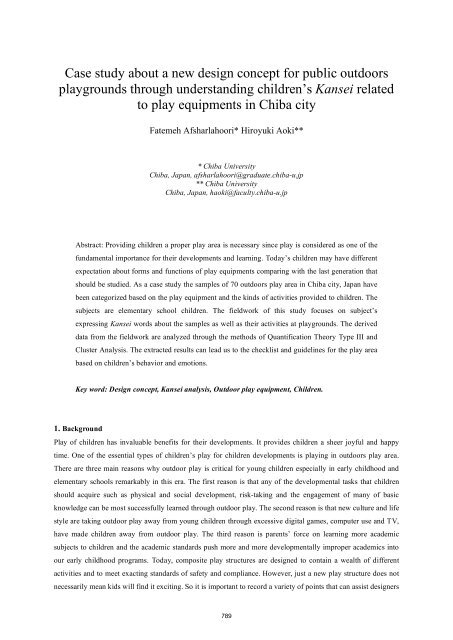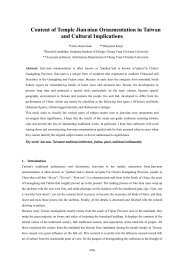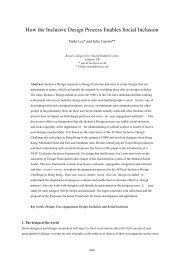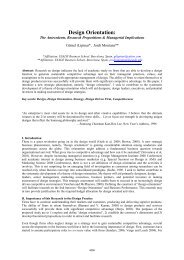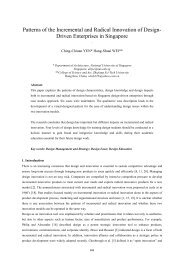Case study about a new design concept for public ... - iasdr 2009
Case study about a new design concept for public ... - iasdr 2009
Case study about a new design concept for public ... - iasdr 2009
You also want an ePaper? Increase the reach of your titles
YUMPU automatically turns print PDFs into web optimized ePapers that Google loves.
<strong>Case</strong> <strong>study</strong> <strong>about</strong> a <strong>new</strong> <strong>design</strong> <strong>concept</strong> <strong>for</strong> <strong>public</strong> outdoors<br />
playgrounds through understanding children’s Kansei related<br />
to play equipments in Chiba city<br />
Fatemeh Afsharlahoori* Hiroyuki Aoki**<br />
* Chiba University<br />
Chiba, Japan, afsharlahoori@graduate.chiba-u.jp<br />
** Chiba University<br />
Chiba, Japan, haoki@faculty.chiba-u.jp<br />
Abstract: Providing children a proper play area is necessary since play is considered as one of the<br />
fundamental importance <strong>for</strong> their developments and learning. Today’s children may have different<br />
expectation <strong>about</strong> <strong>for</strong>ms and functions of play equipments comparing with the last generation that<br />
should be studied. As a case <strong>study</strong> the samples of 70 outdoors play area in Chiba city, Japan have<br />
been categorized based on the play equipment and the kinds of activities provided to children. The<br />
subjects are elementary school children. The fieldwork of this <strong>study</strong> focuses on subject’s<br />
expressing Kansei words <strong>about</strong> the samples as well as their activities at playgrounds. The derived<br />
data from the fieldwork are analyzed through the methods of Quantification Theory Type III and<br />
Cluster Analysis. The extracted results can lead us to the checklist and guidelines <strong>for</strong> the play area<br />
based on children’s behavior and emotions.<br />
Key word: Design <strong>concept</strong>, Kansei analysis, Outdoor play equipment, Children.<br />
1. Background<br />
Play of children has invaluable benefits <strong>for</strong> their developments. It provides children a sheer joyful and happy<br />
time. One of the essential types of children’s play <strong>for</strong> children developments is playing in outdoors play area.<br />
There are three main reasons why outdoor play is critical <strong>for</strong> young children especially in early childhood and<br />
elementary schools remarkably in this era. The first reason is that any of the developmental tasks that children<br />
should acquire such as physical and social development, risk-taking and the engagement of many of basic<br />
knowledge can be most successfully learned through outdoor play. The second reason is that <strong>new</strong> culture and life<br />
style are taking outdoor play away from young children through excessive digital games, computer use and TV,<br />
have made children away from outdoor play. The third reason is parents’ <strong>for</strong>ce on learning more academic<br />
subjects to children and the academic standards push more and more developmentally improper academics into<br />
our early childhood programs. Today, composite play structures are <strong>design</strong>ed to contain a wealth of different<br />
activities and to meet exacting standards of safety and compliance. However, just a <strong>new</strong> play structure does not<br />
necessarily mean kids will find it exciting. So it is important to record a variety of points that can assist <strong>design</strong>ers<br />
789
in creating an environment that children will find irresistible and will enrich their “work” of play. There are<br />
many developmental <strong>design</strong> methods with the aim of recognizing and understanding user’s more needs and<br />
preference <strong>for</strong> products. In Kansei Engineering as one of the human-centered methods the aim is to develop<br />
products that users want to have deeply in their mind and give them satisfaction feeling when using the products.<br />
This method is able to grasp the users Kansei and analyze them and transfer analyzed data <strong>for</strong> promoting the <strong>new</strong><br />
<strong>design</strong> and <strong>design</strong> <strong>concept</strong>s, In the beginning of the 1970s, the <strong>concept</strong> of Kansei Engineering was introduced in<br />
Japan. The Kansei engineering is able to grasp the consumers’ Kansei, to analyze the Kansei using statistical<br />
methods, and to transfer the analyzed data to the <strong>design</strong> domain [1].<br />
Kansei engineering is an engineering tool. It collects the users’ emotional needs and establishes mathematic<br />
prediction models of how the emotional needs are connected to selected product properties [2].<br />
2. Introduction<br />
Childhood is a very critical period in the psychological development of the human’s life. Through the preschool<br />
and early school years, fundamental patterns of physical and motor skills, mental and cognitive skills, self-<br />
<strong>concept</strong>, emotional, and social behaviors are acquired. Having some problems in development in any of the<br />
psychological areas, effect on the child’s subsequent development. The growing body of researches and<br />
literatures discuss <strong>about</strong> play’s potential role in human development and evolution. As knowledge <strong>about</strong> the<br />
benefits of play has grown, the involvement of communities in providing play opportunities has increased.<br />
Playgrounds are a major source of play interaction, funded and supported by communities [3]. From 1920 many<br />
organizations have materialized article and researches <strong>about</strong> play and playgrounds. Those groups developed a list<br />
of equipment most beneficial <strong>for</strong> children of specific ages as a standard of playgrounds and recommended the<br />
equipments <strong>for</strong> children. We know that our society has changed drastically since the 1920s, however the basic<br />
structure of playgrounds has remained almost the same. Some of the standard play equipment may be considered<br />
necessary <strong>for</strong> developing some aspects of motor development, but it is important to provide modified versions of<br />
them in terms of children’s <strong>new</strong> needs and interest. It is crucial that a wider variety of equipments being placed<br />
on modern playgrounds. While industrial <strong>design</strong> and product <strong>design</strong> have been concerned with manufactured<br />
products, the emphasis has been on the objective and physical structures of the products as well as the <strong>for</strong>ms,<br />
shapes, and the material. Even though these are all important but recently the focus has changed from objects to<br />
the experiences that caused by using them. We need to understand experience. We need to understand how<br />
psychology, the social sciences, communication, and business shape a person’s experience [4] In the human-<br />
centered <strong>design</strong> method the prior intention and the aim is to develop the products to the users wants and demands.<br />
Those methods such as Kansei engineering are able to understand the users emotional and analyze them <strong>for</strong><br />
transferring the analyzed data to the <strong>design</strong> issue. During an investigation which was <strong>about</strong> outdoor play<br />
equipments and children’s development; I faced many children who play with play equipments in local parks in<br />
the way that are different from the intended <strong>design</strong> <strong>concept</strong> <strong>for</strong> the equipments. Considering these as a<br />
hypothesis that today’s children, as the main users of outdoor play equipments, have some special need and<br />
wants <strong>about</strong> <strong>for</strong>ms and functions of these equipments; It is essential to recognize their expectation according to<br />
the playground. In this research as a case <strong>study</strong> the numbers of 70 <strong>public</strong> parks in Chiba city (Japan) have been<br />
observed and the existence equipment and facilities in those parks were recognized. In the second step an<br />
interview investigation was carried out with some elementary school children as the subjects of this research.<br />
The aim of the interview was to recognize the most well known equipments as the samples of this research. The<br />
790
numbers of 27 samples were recognized. In the third step the observation investigation have done to find out<br />
<strong>about</strong> the kinds of play and behaviors of children with the samples. The <strong>for</strong>th step was another interview<br />
investigation, the subjects were asked to express Kansei words <strong>about</strong> the samples. The derived data from the<br />
fieldworks are analyzed through the methods of Quantification Theory Type III and Cluster Analysis. The results<br />
of this research would be useful to find the checklist and guidelines <strong>for</strong> the play area based on children’s<br />
behavior and emotions. After all we can get a directions of <strong>new</strong> <strong>concept</strong> <strong>for</strong> <strong>design</strong> of outdoor play area, that<br />
provides children’s emotional preference more and are correspondence with their actual behavior at playgrounds.<br />
3. Steps and methods:<br />
This research just likes most <strong>design</strong> researches, has been completed through two main steps. The first step is<br />
investigation such as observation and interview, the second step is analyzing the gathered data from<br />
investigations.<br />
4. Investigations:<br />
4.1 Investigation on local parks in Chiba city<br />
Chiba is the capital city of Chiba Prefecture, Japan. It is located approximately 40 km east of the center of<br />
Tokyo.Chiba city has 6 wards and on each districts there are some local parks.<br />
In this research 3 wards of Chiba city were investigated and almost 70 parks located in Chuo Ward, Inage Ward<br />
and Mihama Ward were observed. The data of the play facilities and the equipments in parks were recoded by<br />
taking photographs. The parks varieties are from a simple and small green area furnished with just one play<br />
equipment to a wide area furnished with huge compound play equipment set (Fig.2 & 3). There were different<br />
kinds of old and <strong>new</strong> play equipment manufactured from wood, metal, plastic, cement or a combination of two<br />
or more material together.<br />
Figure.1 Map of Japan (Chiba) Figure.2 Component Park Figure.3 Simple Park<br />
The observed play equipments can be categorized into the five main groups according to function and <strong>for</strong>m such<br />
as slides, swing, climbers, tunnels and other play structures. In all of the observed park totally 51 types of play<br />
equipments and play area were recognized. All of them are listed and shown in the following table (Table 1).<br />
Since all of the recorded equipment were not available in most parks and were not well known to all children it<br />
was necessary to choose some samples <strong>for</strong> next steps.<br />
791
Table 1. Recorded play equipments<br />
SLIDES SWINGS CLIMBERS TUNNELS OTHERS<br />
12.Simple 17.Net climber<br />
1.Tube slide swing<br />
30.Net tunnel 35.Arch bridge 48.Jungle gym<br />
18.Arc climber<br />
36.Suspention<br />
2.Animal slide 13.Ball swing<br />
31.Ring tunnel bridge 49.Spring mat<br />
19.Spiral<br />
50.Standing<br />
3.Double slide 14.Belt swing climber 32.Tire tunnel 37.Chain bridge spinner<br />
20. Chain<br />
51.Combinatio<br />
4.Spiral slide 15.Tire swing climber 33.Tube tunnel 38.Hopping pods n set<br />
16.Stand 21.Ramp 34.Cement<br />
5.Straight slide swing<br />
climber tunnel 39.Game panel<br />
22.Ramp with<br />
40.Sand play<br />
6.Wide slide<br />
rope<br />
area<br />
7.Roller slide 23.Scramble net 41.Net mesh<br />
8.Cement slide 24.Wall climber 42.Gym bar<br />
9.Fireman slide<br />
10.Trolley<br />
25.Space net 43.Monkey bar<br />
slider<br />
26.Cliff climber 44.Log roll<br />
27.Over head<br />
11.wave slide<br />
ladder 45.Sea saw<br />
28.Deep rung<br />
climber 46.Balance bar<br />
29.Ring ladder 47.Play house<br />
4.2 Investigation of the most familiar equipments to the subject among observed equipments<br />
After recognizing and recording all the play structures in 70 parks, the numbers of 51 play structures were<br />
identified. In this step, it was needed to choose some samples that are better known to children. So, an<br />
investigation has been conducted to find most familiar equipments to children. The subjects of this research were<br />
11 elementary school children. The photos of all the recorded play structures have shown to the subjects. They<br />
were asked to choose the play equipment, which they have the experience of using them. Children have selected<br />
the numbers of 20 play equipments. The selected equipments are listed in the following table (table 1).<br />
Table 2. The most familiar play equipments to children.<br />
SLIDES SWINGS CLIMBERS TUNNELS OTHERS<br />
6.Simple<br />
13.Tube Tunnel 16.Balance bar<br />
1.Tube slide swing 9.Arc climber<br />
2.Spiral slide 7.Belt swing 10.Chain climber 14.Cement tunnel 17.Hopping pod<br />
3.Roller slide 8.Tire swing 11.Jungle gym 15.Net tunnel 18.Net mesh<br />
4.Cement slide 12. Ramp with rope 19.Spring matt<br />
5.Fireman pole 20.Suspension bridge<br />
4.3 Observation of the children’s behavior and play on the selected equipments<br />
In previous step after the most familiar play equipment to the subjects were recognized as the samples <strong>for</strong> this<br />
research, <strong>for</strong> the next step in this part the behaviors of children with the samples have been observed. The<br />
observation had been conducted while children were playing or doing other activities at the parks. Taking<br />
792
photograph and note writing have recorded the data of the observation. The results show that the local parks in<br />
Japan are used mostly during daytime and afternoon till 5 o’clock. The afternoon users are almost elementary<br />
school kids who go to parks usually soon after going back from school. This observation investigation has<br />
conducted in afternoon hours. The activities of children according to the play equipments can be categorized into<br />
two main lists, the <strong>for</strong>eseen and the un<strong>for</strong>eseen. The <strong>for</strong>eseen <strong>design</strong> activities are the activities and plays that<br />
were the main purpose of the <strong>design</strong> <strong>for</strong> that equipment. For example slid has been considered as a device <strong>for</strong><br />
sliding from up to down. But the second group is the activity and behaviors that children doing in play area and<br />
on the play structures which are different from the <strong>design</strong> intention of the equipment. For example going up from<br />
down to top of the slide, while usually the slides are considered <strong>for</strong> sliding from up to down. Some of the<br />
children’s activities can be seen in the series of photos shown in figure3. Also the physical and behavioral<br />
activities of children during observations are shown in the following tables.<br />
Going to the high parts Seating and chatting Lying down while playing game<br />
Sitting and standing over fence Seal exchange among girls Resting<br />
Playing game (Nintendo Ds) Playing Tag on top of bower Balancing on sea-saw<br />
Figure 3. Some of children’s activities at the samples<br />
793
Table 3. Children’s activities and play at the samples.<br />
All the observed play and activities at the samples The <strong>for</strong>eseen <strong>design</strong> The un<strong>for</strong>eseen<br />
activities<br />
<strong>design</strong> activities<br />
Swinging with<br />
different body<br />
Pushing and puling<br />
Swinging with different<br />
Lie down sliding Balancing<br />
position<br />
body position Squatting Sliding Climbing Couple swinging<br />
Crawling from down to Crawling and knee Going to upper place<br />
Couple swinging<br />
Going to upper place and<br />
top<br />
walking<br />
and roof<br />
roof Sliding Going up Prostrating<br />
Prostrating Stand sliding Hand over hand Backward sliding<br />
Going up over the tube<br />
Going upward on the<br />
Backward sliding slide Hanging by arms slide<br />
Playing games and<br />
Going upward on the slide Ball playing Hopping and skipping card games<br />
Group playing Lying down & resting Jumping Competition<br />
Playing games and card<br />
Jumping from upper<br />
games Climbing Lifting<br />
part<br />
Competition Hopping and skipping Pushing and pulling Chatting<br />
Jumping between two<br />
Going to the reverse<br />
Parallel play (peer) high parts Sliding<br />
side of the bar<br />
Jumping from upper part Playing baseball Swinging Lie down sliding<br />
Chatting Tag playing (Onigokko) Squatting Sliding<br />
Going to the reverse side<br />
Crawling from down<br />
of the bar Reading book<br />
to top<br />
Hanging Stand sliding<br />
Going up over the<br />
Creeping<br />
tube slide<br />
Lying down &<br />
Balancing<br />
resting<br />
Crawling and knee<br />
Jumping between two<br />
walking<br />
high parts<br />
Tag<br />
Running<br />
playing(Onigokko)<br />
4.4Interview investigation on subjects’ impression <strong>about</strong> samples (play equipments) to derive<br />
Kansei keywords<br />
The subjects <strong>for</strong> this investigation were 11 elementary school children girls and boys living in Chiba city. The<br />
photos of the selected sample of play equipments have shown to them. While looking on each photo they were<br />
asked to answer this question: “ what was your impression when using this equipment?” or “ what kind of feeling<br />
or emotion did you have when using this play area?” then the answers were recorded on a note. The results of<br />
this interview investigation gave us 72 keywords and phrase <strong>about</strong> the subjects’ impression expression. The<br />
derived Kansei keywords and phrases have been summarized into major Kansei descriptive words, which were<br />
13 main keywords and phrases.<br />
5. Analysis<br />
5.1 Characterizing each of the resulted groups of equipments through the Kansei descriptive<br />
words relevant to the facilities belonging to the group<br />
In this step the derived data of interview investigation from the Kansei keywords <strong>about</strong> play equipments<br />
expressed by children have been analyzed and clustered into the main groupings of impression words. The used<br />
794
methods <strong>for</strong> the analysis are Quantification Theory Type III and Cluster Analysis. The distribution of the<br />
samples in the resulted grouping shows the character of each sample based on subject’s impression.<br />
As the output of analyzing the collected samples of play equipments and Kansei keywords, the chosen cut-off<br />
line <strong>for</strong> the clustering algorithm has yield 6 major clusters. Figure 4 show the cluster of the samples. The output<br />
graph of distribution of the samples and their grouping is shown in Figure 5 .The laid samples in the top and<br />
bottom of the graph tend to ‘Ecstasy’ and ‘Pleasure’, axis ‘Y’ is concerned with emotional aspects. But the<br />
distribution of the ‘Exercise’ and ‘Discovery’ from samples in the left and right sides of the graph leads to<br />
allocate axis ‘X’ <strong>for</strong> the structure of the physical and mental aspects of equipment. The resulted clusters are<br />
named as: C1: Fear, C2: Speedy, C3: Adventure, C4: Surprising, C5: Joy and C6: Exercise. The given name to<br />
each cluster is decided based on the characteristics play equipment and the activity, which is provided to children.<br />
Mental Aspects<br />
Figure 4. Clusters of Kansei keywords <strong>about</strong> play equipments samples<br />
-4 Cool -3<br />
(refereshing)<br />
Very interesting<br />
-2<br />
C3<br />
Painful<br />
Resemble of being in<br />
0 C1<br />
a train<br />
Frightening<br />
-1 0 Feel of 1<br />
Interesting<br />
falling Resemble<br />
-1 Beneficial <strong>for</strong> earthquake<br />
balance<br />
2 3<br />
C4<br />
C2<br />
Fast<br />
Ecstasy<br />
4<br />
3<br />
2<br />
1<br />
-2<br />
-3<br />
Pleasure<br />
-4<br />
X-Y<br />
Fine<br />
Enjoyable<br />
Hard<br />
Figure 5. Distribution of the collected the Kansei words and the samples<br />
The Cluster C1 (Fear) is placed in ‘ Physical Aspects’-‘Pleasure’ area of the graph. It can be described through a<br />
series of unstable feeling such as Fell of falling and frightening with enjoyable movements, which caused the<br />
subjects act in more physical activity on the play equipment while give the subjects feel of Pleasure. Such as<br />
795<br />
C5<br />
C6<br />
Physical Aspects<br />
X-Y
using the equipment like Suspension bridge. The C5 (Joy) is almost located in same area with Cluster C1 but it<br />
more near to ‘Pleasure’ direction of the graph. It presents more joyful feeling to children, such as the feeling<br />
caused when using a Chain climber.<br />
The Cluster C2 (Speedy) is laid above the central areas of the graph near the ‘ Ecstasy’ direction of the graph. It<br />
presents the regular activity such as sliding which is enjoyable and fast.<br />
The Cluster C3 (Adventure) is settled in the central area of the graph on the ‘Mental Aspect’ direction. It is<br />
consists of two groups of Kansei keywords which are in two different groups of emotional expression. Such as<br />
Painful and Very interesting, that is the reason <strong>for</strong> calling this Cluster as Adventure. It can be explain as the<br />
mental aspects feelings. The Cluster C4 (Surprising) is near the ‘Mental Aspects’ of the graph. It presents such<br />
feeling like surprising and discovery. For example when a child go to inside a tunnel and find it darker and<br />
cooler than outside. The Cluster C6 (Hard) is placed on the ‘Ecstasy’ –‘Physical Aspect’ area of the graph. The<br />
most effective aspects of this group is the feeling caused by a tough ef<strong>for</strong>t, such as the feeling caused while<br />
going up on a Ramp. All the derived Kansei keywords from this investigation are shown in Table 4.<br />
Table 4. The Clusters of Kansei keywords<br />
C1: Fear C2: Speedy C3: Adventure C4: Surprising C5: Joy and C6:<br />
Exercise.<br />
Resemble<br />
Cool (refreshing) Enjoyable Hard<br />
earthquake Fast Painful<br />
Resemble of being<br />
Feel of falling<br />
Beneficial <strong>for</strong><br />
Fine in a train<br />
balance<br />
Frightening<br />
Interesting<br />
Very interesting<br />
The samples of play equipments used in this research also has been analyzed and grouped with the methods of<br />
Quantification Theory Type III and Cluster Analysis and the output of analyzing the collected samples of play<br />
equipments and Kansei keywords, the selected cut-off line <strong>for</strong> the clustering algorithm gave us 9 major clusters.<br />
Some Cluster contains only one equipment, but some has more than one equipments. Shown in Figure 5. And<br />
the Table 5, shows the Cluster of play equipments’ samples.<br />
Equipments upon Kansei<br />
C4<br />
2<br />
Fireman pole<br />
Hopping pod<br />
1<br />
Roller slide C2<br />
Cement slide<br />
C8<br />
-4 -3<br />
Cement Tunnel<br />
Balance bar Belt swing<br />
C5 Jungle gym<br />
Arch climber 0<br />
-2 -1 0 1 2 Simple Swing<br />
Spiral slide<br />
Tunnel Tire swing<br />
Suspension<br />
Tube slide<br />
C1 Net mesh -1 bridge Net tunnel<br />
C3<br />
3<br />
4<br />
3<br />
-2<br />
-3<br />
-4<br />
Spring matt<br />
C6<br />
C9<br />
Ramp with rope<br />
C7<br />
Chain climber<br />
Figure 5. Clusters and Distribution of play equipments upon Kansei keywords<br />
796
Table 5. The Clusters of samples of play equipments based on Kansei keywords<br />
Cluster 1<br />
Cluster 2<br />
Cluster 3<br />
Spiral slide<br />
Net tunnel<br />
Spring matt<br />
Cluster 4 Hopping<br />
pod<br />
Cluster 5 Simple<br />
Swing<br />
Cluster 6 Cement<br />
slide<br />
Cluster 7 Chain<br />
climber<br />
Cluster 8 Cement<br />
tunnel<br />
Cluster 9 Ramp with<br />
rope<br />
6 Discussion and conclusion<br />
Tunnel Net mesh Balance<br />
bar<br />
Tube Suspension<br />
slide bridge Belt swing<br />
Roller<br />
slide Fireman pole<br />
Arch<br />
climber<br />
Jungle<br />
gym<br />
Tire<br />
swing<br />
In this case <strong>study</strong> research, the expressed Kansei keywords <strong>about</strong> outdoor play equipment can be classified into<br />
six Clusters named as Fear, Speedy, Adventure, Surprising, Joy and Exercise. Each of those groups has its<br />
particular impression <strong>for</strong> users. There is also a close relationship between the function and <strong>for</strong>ms of play<br />
equipments and the derived Kansei keywords. The <strong>new</strong> <strong>design</strong> <strong>concept</strong> <strong>for</strong> the outdoors play equipments based<br />
on children’s expressing Kansei emotional words can be create through a series of investigation with more<br />
subjects. For further studies it is better to focus on children group playing and social play at play areas, since one<br />
of the important parts of emotional feeling caused between two or more children.<br />
7. References and Citations<br />
[1] Nagamachi, M (2007) Perspectives and <strong>new</strong> trend of Kansei/Affective Engineering. [Online PDF]. Available<br />
at[Accessed May 2008]<br />
[2] Nagamachi, M. (1989). Kansei Engineering. Kaibundo, Tokyo<br />
[3] Hendrik N. J. Schifferstein, Paul Hekkert, ScienceDirect (2008) Product Experience, 1th Ed, Elsevier<br />
[4] Gemstone Universal Playgrounds Team (2003) Universal Playgrounds: Integrating All Children Through<br />
Play. [Online PDF]. Available at [Accessed<br />
July 2008]<br />
797


